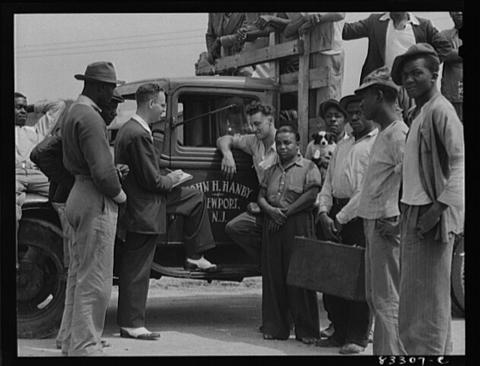
Description
The Farm Security Administration (FSA) was created during the Great Depression in 1937 under the Department of Agriculture with the purpose of helping with rural rehabilitation, farm loans and subsistence homestead programs. How the FSA fulfilled its mission was to create a network of cooperation between states and county offices to help clients who needed loans but could not get credit elsewhere. The organization also produced almost 80,000 pictures of depression era life. However, the mission of those capturing images shifted during World War II when the FSA became part of the Office of War Information and the focus on capturing "positive" images of what was occurring on the homefront became a priority. This photograph was taken in Bridgeton, New Jersey at an FSA agricultural workers' camp. George Price, seen on the left with a clipboard, was a U.S. employment agent who was writing up contracts for the pickers who would work and live on John Hanby's farm.
Source-Dependent Questions
- How different would this image have looked prior to World War II? How does the number of workers needed show the significance of agriculture to winning the war effort?
- If the Farm Security Administration (FSA) used this photo for propaganda purposes, how might they use it?
- Compare this photograph with the image of the Girl Scouts planting a Victory Garden. Who were the intended audiences for each of these photographs? Is there any overlap in intended audiences? Why or why not?
Citation Information
Collier, John, Jr., "Bridgeton, New Jersey. FSA (Farm Security Administration) agricultural workers' camp. George Price, United States employment agent writing up contract for the pickers whom John Hanby is taking to his own farm to live and work," July 1942. Courtesy of Library of Congress